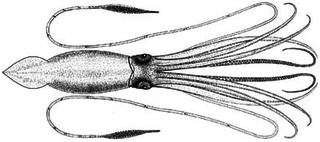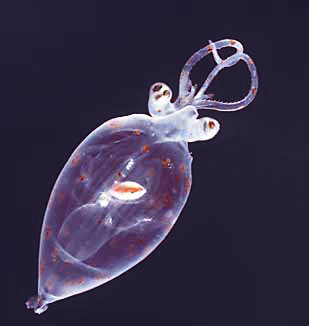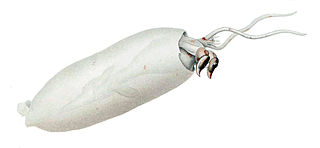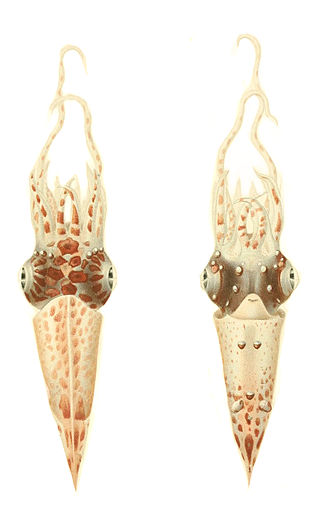
A squid is a mollusc with an elongated soft body, large eyes, eight arms, and two tentacles in the superorder Decapodiformes, though many other molluscs within the broader Neocoleoidea are also called squid despite not strictly fitting these criteria. Like all other cephalopods, squid have a distinct head, bilateral symmetry, and a mantle. They are mainly soft-bodied, like octopuses, but have a small internal skeleton in the form of a rod-like gladius or pen, made of chitin.

The giant squid is a species of deep-ocean dwelling squid in the family Architeuthidae. It can grow to a tremendous size, offering an example of abyssal gigantism: recent estimates put the maximum size at around 12–13 m (39–43 ft) for females and 10 m (33 ft) for males, from the posterior fins to the tip of the two long tentacles. The mantle of the giant squid is about 2 m long, and the length of the squid excluding its tentacles rarely exceeds 5 m (16 ft). Claims of specimens measuring 20 m (66 ft) or more have not been scientifically documented.
The Chiroteuthidae are a family of deep-sea squid, generally small to medium in size, rather soft and gelatinous, and slow moving. They are found in most temperate and tropical oceans, but are known primarily from the North Atlantic, North Pacific, and Indo-Pacific. The family is represented by approximately 12 species and four subspecies in four genera, two of which are monotypic. They are sometimes known collectively as whip-lash squid, but this common name is also applied to the Mastigoteuthidae, which are sometimes treated as a subfamily (Mastigoteuthinae) of Chiroteuthidae.

The family Cranchiidae comprises the approximately 60 species of glass squid, also known as cockatoo squid, cranchiid, cranch squid, or bathyscaphoid squid. Cranchiid squid occur in surface and midwater depths of open oceans around the world. They range in mantle length from 10 cm (3.9 in) to over 3 m (9.8 ft), in the case of the colossal squid. The common name, glass squid, derives from the transparent nature of most species. Cranchiid squid spend much of their lives in partially sunlit shallow waters, where their transparency provides camouflage. They are characterised by a swollen body and short arms, which bear two rows of suckers or hooks. The third arm pair is often enlarged. Many species are bioluminescent organisms and possess light organs on the undersides of their eyes, used to cancel their shadows. Eye morphology varies widely, ranging from large and circular to telescopic and stalked. A large, fluid-filled chamber containing ammonia solution is used to aid buoyancy. This buoyancy system is unique to the family and is the source of their common name "bathyscaphoid squid", after their resemblance to a bathyscaphe. Often the only organ that is visible through the transparent tissues is a cigar-shaped digestive gland, which is the cephalopod equivalent of a mammalian liver. This is usually held in a vertical position to reduce its silhouette and a light organ is sometimes present on the lower tip to further minimise its appearance in the water.

Ommastrephidae is a family of squid containing three subfamilies, 11 genera, and over 20 species. They are widely distributed globally and are extensively fished for food. One species, Todarodes pacificus, comprised around half of the world's cephalopod catch annually.

The European squid or common squid is a large squid belonging to the family Loliginidae. It occurs abundantly in coastal waters from the North Sea to at least the west coast of Africa. This species lives from sea level to depths of 500 m (1,600 ft). Its mantle is up to 40 cm (16 in) long. The species is extensively exploited by commercial fisheries.
Egea inermis is a species of glass squid in the monotypic genus Egea.

Bathothauma lyromma, the lyre cranch squid, is a highly modified species of glass squid from the family Cranchiidae with a distribution which encompasses most of the world's oceans from the tropics to high latitudes.

Sandalops melancholicus, the sandal-eyed squid or melancholy cranch squid, is a small species of glass squid. It is known to reach a mantle length of 11 cm (4.3 in). It is distributed in the tropical and subtropical oceans around the world. It is the only species in the genus Sandalops but some authorities suggest that this may be a species complex rather than a monotypic genus.
Mastigopsis is a genus of whip-lash squid containing one single species, Mastigopsis hjorti. Some teuthologists consider Idioteuthis synonymous with this taxon; however, genetic results indicate that this genus is not closely related with Idioteuthis but actually closer to Magnoteuthis.
Stigmatoteuthis arcturi, commonly known as the jewelled squid, is a species of cock-eyed squid from the family Histioteuthidae. It occurs throughout the subtropical and tropical Atlantic Ocean in the mesopelagic zone.

Pterygioteuthis giardi is a species of squid in the family Pyroteuthidae. It is known as the roundear enope squid. The specific name honors the French zoologist and marine biologist Alfred Mathieu Giard (1846-1908).
Teuthowenia pellucida, the googly-eyed glass squid, is a rare deep-sea glass squid whose habitat ranges throughout the oceans of the Southern Hemisphere.
Lolliguncula brevis, or the Atlantic brief squid, is a small species of squid in the Loliginidae family. It is found in shallow parts of the western Atlantic Ocean.

Sepioteuthis lessoniana, commonly known as the bigfin reef squid, glitter squid or oval squid, is a species of loliginid squid. It is one of the three currently recognized species belonging to the genus Sepioteuthis. Studies in 1993, however, have indicated that bigfin reef squids may comprise a cryptic species complex. The species is likely to include several very similar and closely related species.

Illex coindetii, commonly known as the southern shortfin squid or broadtail shortfin squid, is a species of neritic squids in the family Ommastrephidae. They are found in the Mediterranean Sea and on both sides of the north Atlantic Ocean.

Teuthowenia megalops, sometimes known as the Atlantic cranch squid, is a species of glass squid from the subarctic and temperate waters of the northern Atlantic Ocean. They are moderately sized squid with a maximum mantle length of 40 cm (16 in). Their very large eyes are the source for the specific name megalops. Like other members of the genus Teuthowenia, they are easily recognizable by the presence of three bioluminescent organs (photophores) on their eyeballs.

Taonius belone is a glass squid belonging to the genus Taonius from the family Cranchiidae. It occurs in the northern subtropical and in the tropical or equatorial waters of the Pacific Ocean and the Indian Ocean.
Eucleoteuthis is a monotypic genus of squid from the family Ommastrephidae; the only species is Eucleoteuthis luminosa, the striped flying squid or luminous flying squid.

The European flying squid is a species of squid from the continental slope and oceanic waters of the eastern Atlantic Ocean and the Mediterranean Sea. It is the type species of the genus Todarodes, the type genus of the subfamily Todarodinae of the pelagic squid family Ommastrephidae. It is a species which is targeted by some fisheries, although it is more often a bycatch.













